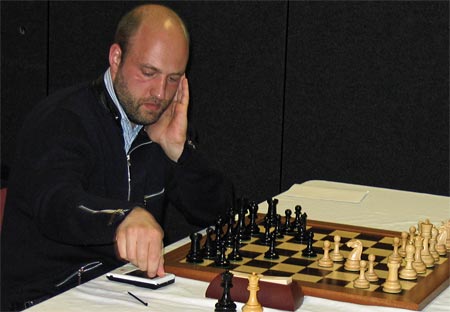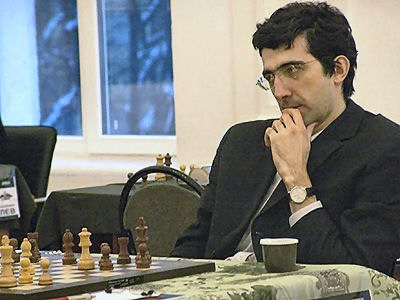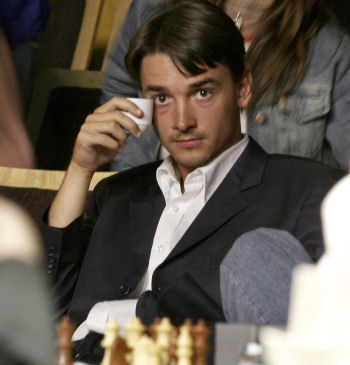| Latest | Greatest | Lobby | Journals | Search | Options | Help | Login |
|
|
|
This topic is archived. |
| Home » Discuss » Topic Forums » Sports |
|
| Jack Rabbit
|
Sun Apr-06-08 05:08 PM Original message |
| The Jack Rabbit Chess Report (April 6): Russian team championships in Sochi |
|
Russian Team Championships Begin
 The annual Russian team championships started in the Black Sea resort of Sochi last Wednesday. The defending champions, Tomsk 400, is off to a slow start. Tomak lost its first four matches, all withou its leading player, reigning Russian national champion Alexander Morozevich, who is ranked third in the world. Morozevich played today and defeated former world champion Anatoly Karpov in a 111-move marathon as Tomsk ran over Southern Ural of Chelyabinsk, 4-2. The current leader of the tournament is Northern Ural of Ekaterinaburg, led by Azerbaijani star Teimour Radjabov and includes one naturalized American, Gata Kamsky. Etaterinaburg won its match today against Saratov. Radjabov won his individual game against former Russian national champion Evgeny Alekseev. Dutch National Championships Underway  The annual Dutch national championships began last Wednesday in Hilversum. Twelve players, all men, are competing in the general competition. The ladies' competition, with ten players, began Friday. After today's fifth round, Yge Visser is leading with 3� points, with seven players tied for second, including defending champion Sergei Tiviakov and Daniel Stellwagen, who lost last year's tournament to Tiviakov in a rapid playoff. The ladies completed the third round today. Bianca Muhren is the only participant to win all three of her games so far and leads defending champion Peng Zhaoqin by a half point. Mw. Peng, 39, is playing for her ninth consecutive national women's title. |
| Printer Friendly | Permalink | | Top |
| Jack Rabbit
|
Sun Apr-06-08 05:10 PM Response to Original message |
| 1. Games of the Foxwoods Five |
|
Five players tied for first place in the Foxwoods Open in Mashantuckt, Connecticut, this year. The JRCR presents one game won by each of the five.
Diagrams on the Jack Rabbit Chess Report are made with Chess M�rida, a true type font that can be downlaoded free here. !""""""""# $tMvWlVmT% $OoOoOoOo% $ + + + +% $+ + + + % $ + + + +% $+ + + + % $pPpPpPpP% $RnBqKbNr% /(((((((() WHITE White to move (This position is a theoretical draw) |
| Printer Friendly | Permalink | | Top |
| Jack Rabbit
|
Sun Apr-06-08 05:15 PM Response to Reply #1 |
| 5. Shulman-Hess, Round 6 |
 Yury Shulman Yury Shulman - Robert Hess Foxwoods Open, Round 6 Mashantucket, Connecticut, 22 March 2008 King's Gambit: Fischer Defense 1.e4 e5 2.f4 exf4 3.Nf3 d6
4.d4 g5 5.h4 g4 6.Ng1 f3
7.Bg5
7...Be7 8.Qd2 f2+!?
9.Kxf2
9...h6 10.Bxe7 Qxe7 11.Nc3 Nc6
12.Nd5 Nf6
13.Re1 Qd8 14.c3
14...Be6 15.Nf4
15...g3+!?
16.Kxg3 Rg8+ 17.Kf3
17...Qe7?
18.Nd5
18...Nxe4
!""""""""# $t+ +l+t+% $OoO Wo+ % $ +mOv+ O% $+ +n+ + % $ + P + P% $+ P +k+ % $pP Q +p+% $+ + RbNr% /(((((((() WHITE: Yury Shulman Position after 18...Nf6e4:p 19.Nxc7+?
19...Qxc7?
20.Rxe4
20...0-0-0 21.Kf2!
21...d5 22.Rf4 Ne7 23.Bd3 Rg7
24.Nf3 Rdg8 25.Rg1 Rg3
26.Ne5
26...Nc6
27.Nf3 h5 28.Be2
28...R3g6
!""""""""# $ +l+ +t+% $OoW +o+ % $ +m+v+t+% $+ +o+ +o% $ + P R P% $+ P +n+ % $pP QbKp+% $+ + + R % /(((((((() WHITE: Yury Shulman Position after 28...Rg3g6 29.Ng5!
29...Bg4 30.Rxf7 Qb6
31.Bxg4+ hxg4 32.Re1 a5 33.b3 Kb8
34.Qf4+ Ka7 35.Qxg4
35...Nd8 36.Rfe7 Qf6+ 37.Qf3
37...Qh8
38.Qh3 Qf6+
39.Kg1
39...Rf8 40.Qe3 Rh6 41.g3 Qc6 42.Rf1 Rhf6 43.Rxf6 Qxf6 44.Qe2 1-0
|
| Printer Friendly | Permalink | | Top |
| Jack Rabbit
|
Sun Apr-06-08 05:16 PM Response to Reply #1 |
| 6. Paragua-Shabalov, Round 7 |
|
Reigning US national champion Alex Shabalov is today's most uncompromising exponent of the romantic school. Here he plays a system advocated by his mentor, the late former world champion Mikhail Tal.
 Alex Shabalov Mark Paragua - Alex Shabalov Foxwoods Open, Round 7 Mashantucket, Connecticut, 22 March 2008 West India Game: Tal-Indian Defense (Modern Benoni) 1.d4 Nf6 2.Nf3 e6 3.c4 c5 4.d5 exd5 5.cxd5 g6
6.Nc3 d6 7.e4
7...Bg7 8.Nd2
8...0-0 9.Be2 Na6 10.0-0 Nc7 11.Re1 11...Re8
12.Qc2 Rb8 13.a4 b6!?
14.Nc4
14...Ba6 15.Bf4
15...Bxc4 16.Bxc4 a6 17.Qd3 Ng4
18.Qg3 Ne5 19.Bf1 b5!?
20.axb5 axb5 21.Bg5 Qc8 22.Ra5
22...c4 23.Na2 Na6 24.Nc3 Nc7 25.Be3
25...Rb7 26.Na2
26...Ng4 27.Qxd6 Bxb2
28.Qc5
28...Qd8 29.Qc6 Rb8 30.Bf4?
!""""""""# $ T Wt+l+% $+ M +o+o% $ +q+ +o+% $Ro+pM + % $ +o+pB +% $+ + + + % $nV + PpP% $+ + RbK % /(((((((() WHITE: Mark Paragua Position after 30.Be3f4 30...Ne5!
31.Bxe5 Bxe5 32.Ra7 Qd6
33.Qxd6
33...Bxd6 34.g3 f6
35.Kg2 Ra8 36.Rxa8 Rxa8 37.Nc3 g5
38.Rb1 b4 39.Nd1
39...c3 40.Ne3 Bc5 41.Bc4
41...Kf8 42.Nc2 Ne8
43.f3 Nd6 44.Bb3 g4 45.h3 gxf3+!
46.Kxf3 !""""""""# $t+ + L +% $+ + + +o% $ + M O +% $+ Vp+ + % $ O +p+ +% $+bO +kPp% $ +n+ + +% $+r+ + + % /(((((((() WHITE: Mark Paragua Position after 46.Kg2f3:p 46...Re8!
47.Re1 Re5 48.g4 Ke7 49.Re2
49...Kd8 50.Re1 Kc7
51.h4 h6 52.Re2 Kb6 53.Ne1 Kb5 54.Nd3 !""""""""# $ + + + +% $+ + + + % $ + M O O% $+lVpT + % $ O +p+pP% $+bOn+k+ % $ + + + +% $+ + + + % /(((((((() WHITE: Mark Paragua Position after 54.Ne1d3 54...Nc4!!
55.Nxe5 Nxe5+ 56.Kg3 Nd3 57.Rc2 Bd6+ 0-1
|
| Printer Friendly | Permalink | | Top |
| Jack Rabbit
|
Sun Apr-06-08 05:22 PM Response to Reply #1 |
| 7. Friedel-Becerra, Round 9 |
 Julio Becerra Josh Friedel - Julio Becerra Foxwoods Open, Round 9 Mashantucket, Connecticut, 23 March 2008 Spanish Grand Royal Game: Chigorin Defense (Keres Variation) 1.e4 e5 2.Nf3 Nc6 3.Bb5 a6 4.Ba4 Nf6 5.0-0 Be7 6.Re1 b5 7.Bb3 d6 8.c3 0-0 9.h3 Na5
10.Bc2 c5 11.d4 Nd7
12...exd4 13.cxd4 Nc6
14.d5 Nce5 15.a4
15...Rb8
16.axb5 axb5 17.Nxe5
17...Nxe5 18.f4 Ng6 19.Nf3 f5!?
20.exf5
20...Bxf5 21.Bxf5 Rxf5 22.g4
22...Rxf4!?
23.Bxf4 Nxf4 24.Qd2
24...Ng6?!
25.Qe3 Qd7
26.Qe6+ Qxe6 27.Rxe6 b4 28.g5
!""""""""# $ T + +l+% $+ + V Oo% $ + Or+m+% $+ Op+ P % $ O + + +% $+ + +n+o% $ P + + +% $R + + + % /(((((((() WHITE: Josh Friedel Position after 28.g4g5 28...Bf8!
29.Re4
29...Ne7 30.Rd1 Ra8 31.Nh4 g6 32.Re6 Rd8 33.Kg2
33...Rd7
34.Kf3
34...b3 35.Re3
35...Rb7 36.Re6 Rd7
37.Re2 Bg7 38.Ke4 Rb7 39.Ra1?!
!""""""""# $ + + Vl+% $+ + + +o% $ + Or+ +% $+ Op+oP % $ + + K +% $+o+ + +p% $ P + + +% $+ +r+ + % /(((((((() WHITE: Josh Friedel Position after 39.Rd1a1 39...Rb4+!
40.Kf3 Be5
41.Ng2
41...Nxd5 42.Ra8+ Kf7 43.Ra7+ Ke6
44.Rxh7 c4 45.Rh4 Ra4 46.Rd4?
!""""""""# $ + + + +% $+ + + + % $ + Ol+o+% $+ +mV P % $t+o+ + +% $+o+ +k+p% $ P +r+n+% $+ + + + % /(((((((() WHITE: Josh Friedel Position after 46.Rh4d4 46...Nb6!
47.Rd1
47...Ra2
48.Kg4
48...Nd5 49.Rdd2 c3 50.bxc3 Nxc3
51.Nf4+ Kf7 52.Rf2 Ra4
53.Rf1
53...Rb4 54.h4 Ke8
55.h5 b2 56.Rxb2
56...gxh5+ 57.Kxh5 Rxb2 58.Nd3
58...Rh2+ 59.Kg6 Bh8
60.Rf7 Bd4 61.Nb4
61...Re2 62.Rh7
62...d5 63.Kf5 Re5+ 64.Kf4 Ne2+ 65.Kf3
65...Bc5 66.Na6
66...Bd6 67.g6 Nd4+ 68.Kg4 Ne6 0-1
|
| Printer Friendly | Permalink | | Top |
| Jack Rabbit
|
Sun Apr-06-08 05:23 PM Response to Reply #1 |
| 8. Hess-Ivanov, Round 3 |
|
Edited on Sun Apr-06-08 05:24 PM by Jack Rabbit
Robert Hess is a New York teenager who pkays linebacker for his high school's football team.
A newly minted international master, the young man earned a GM norm by scoring 7 points in the Foxwoods Open.  Robert Hess Robert Hess - Alexander Ivanov Foxwoods Open, Round 3 Mashantucket, Connecticut, 20 March 2008 Closed German Game: Robatsch Defense 1.e4 g6
2.d4 Bg7 3.Nc3 c6
4.h4
4...d5
5.e5 f6!?
6.f4
6...h5
7.Bd3 Kf7 8.Qe2 Nh6 9.Be3
9...Bg4 10.Nf3 Nf5
11.Qf2
11...Nd7 12.Bd2 Bxf3 13.gxf3
13...Qb6
14.Na4 Qc7 15.Rg1 e6 16.0-0-0 Rag8
17.Rg2
17...Bf8
18.Rdg1
18...Be7 19.Nc3
19...Qd8
!""""""""# $ + W +tT% $Oo+mVl+ % $ +o+oOo+% $+ +oPm+o% $ + P P P% $+ Nb+p+ % $pPpB Qr+% $+ K + R % /(((((((() WHITE: Robert Hess Position after 19...Qc7d8 20.Ne4!?
20...dxe4 21.fxe4 Nh6
22.f5 Ng4?
23.fxe6+
23...Kg7
!""""""""# $ + W +tT% $Oo+mV L % $ +o+pOo+% $+ + P +o% $ + Pp+mP% $+ +b+ + % $pPpB Qr+% $+ K + R % /(((((((() WHITE: Robert Hess Position after 23...Kf7g7 24.Rxg4!!
24...hxg4 25.Rxg4 Nf8
26.exf6+ Bxf6 27.e5 Rh5
28.exf6+ Qxf6 29.Rf4 Qxe6 30.d5 Qxd5 31.Rf7+ 1-0
|
| Printer Friendly | Permalink | | Top |
| Jack Rabbit
|
Sun Apr-06-08 05:56 PM Response to Reply #1 |
| 9. Ivanov-Esserman, Round 2 |
 Alexander Invanov Alexander Ivanov - Marc Esserman Foxwoods Open, Round 2 Mashantucket, Connecticut, 20 March 2008 Open Sicilian Game: Zagreb Opening 1.e4 c5 2.Nf3 d6 3.d4 cxd4 4.Nxd4 Nf6 5.Nc3 a6 6.g3!?
6...e6
7.Bg2 Qc7 8.0-0 Be7
9.g4
9...g5!?
10.Bxg5 Rg8 11.f4 h6
12.Bxf6 Bxf6 13.Kh1 Nc6?
14.e5 dxe5 15.Nxc6
15...bxc6 16.Ne4!
16...Be7 17.fxe5 Qxe5 18.Qf3 Kd8
19.Rad1+ Bd7 20.Ng5 Qxg5
!""""""""# $t+ L +t+% $+ +vVo+ % $o+o+o+ O% $+ + W N % $ + + +p+% $+ + +q+ % $pPp+ +bP% $+ +r+r+k% /(((((((() WHITE: Alexander Ivanov Position after 20...Qe5g5:N 21.Rxd7+!!
21...Kxd7 22.Qxc6+ Kd8 23.Qxa8+ Kd7 24.Qc6+ 1-0
|
| Printer Friendly | Permalink | | Top |
| Jack Rabbit
|
Sun Apr-06-08 05:11 PM Response to Original message |
| 2. From Nice |
|
Diagrams on the Jack Rabbit Chess Report are made with Chess M�rida, a true type font that can be downlaoded free here. !""""""""# $tMvWlVmT% $OoOoOoOo% $ + + + +% $+ + + + % $ + + + +% $+ + + + % $pPpPpPpP% $RnBqKbNr% /(((((((() WHITE White to move (This position is a theoretical draw) |
| Printer Friendly | Permalink | | Top |
| Jack Rabbit
|
Sun Apr-06-08 05:12 PM Response to Reply #2 |
| 3. Kramnik-Topalov, Rapid Competirion, Round 5 |
 Vladimir Kramnik Vladimir Kramnik - Veselin Topalov Melody Amber Tournament, Rapid Competition, Round 5 Nice, 20 March 2008 West India Game: King's Indian Defense 1.d4 Nf6 2.c4 g6 3.Nc3 Bg7 4.e4 d6 5.Nf3 0-0 6.Be2 e5 7.0-0 Na6
8.Be3
8...Ng4 9.Bg5 Qe8 10.Re1
10...exd4 11.Nd5
11...d3!?
!""""""""# $t+v+wTl+% $OoO +oVo% $m+ O +o+% $+ +n+ B % $ +p+p+m+% $+ +o+n+ % $pP +bPpP% $R +qR K % /(((((((() WHITE: Vladimir Kramnik Position after 11...d4d3 12.Bxd3 c6
13.Ne7+ Kh8 14.Nxc8 Rxc8 15.Bf1 Nc5
16.Qxd6 Nxe4 17.Qa3
17...f5 18.h3
18...Ne5 19.Bf4
19...Nd7?
20.Qxa7 Bxb2
21.Rab1 Bg7
22.Qxb7 Ndc5
23.Qb6 Rf7 24.Ng5 Rb7
!""""""""# $ +t+w+ L% $+t+ + Bo% $ Qo+ +o+% $+ M +oN % $ +p+mB +% $+ + + +p% $p+ + Pp+% $+r+ RbK % /(((((((() WHITE: Vladimir Kramnik Position after 24...Rf7b7 25.Qxb7!!
25...Nxb7 26.Rxb7 Kg8
27.c5!
27...h6 28.Bc4+ Kh8 29.Be5 hxg5
30.Bxg7+ Kh7 31.Bf8+ Kh8
32.Be7 Rb8 33.Rxe4 1-0
|
| Printer Friendly | Permalink | | Top |
| Jack Rabbit
|
Sun Apr-06-08 05:13 PM Response to Reply #2 |
| 4. van Wely-Morozevich, Blindfold Competition, Round 6 |
 Alexander Morozevich Loek van Wely - Alexander Morozevich Melody Amber Tournament, Blindfold Competition, Round 6 Nice, 21 March 2008 Queen's Gambit: Albin Counter-Gambit 1.d4 d5 2.c4 e5!?
3.dxe5 d4 4.Nf3
4...Nc6 5.Nbd2 Nge7
6.a3
6...Be6 7.g3 Qd7 8.Bg2 Bh3!?
9.0-0 Bxg2 10.Kxg2 0-0-0 11.b4
11...Ng6
12.Bb2 h5 13.b5!?
13...Ncxe5 14.Bxd4 Nxf3 15.Nxf3
15...h4 16.Bxa7?!
!""""""""# $ +lT V T% $BoOw+oO % $ + + +m+% $+p+ + + % $ +p+ + O% $P + +nP % $ + +pPkP% $R +q+r+ % /(((((((() WHITE: Loek van Wely Position after 16.Bd4xa7 16...Qg4!
17.Qc2?
17...hxg3 18.fxg3 !""""""""# $ +lT V T% $BoO +oO % $ + + +m+% $+p+ + + % $ +p+ +w+% $P + +nP % $ +q+p+ P% $R + +r+ % /(((((((() WHITE: Loek van Wely Position after 18.fg3:p 18...b6!
19.a4
19...Bd6
20.e3 Rh3
21.Kh1 Rdh8 22.Rf2 Bxg3 23.Rg1 Qxf3+ 0-1
|
| Printer Friendly | Permalink | | Top |
| DU
AdBot (1000+ posts) |
Sun May 05th 2024, 02:45 AM Response to Original message |
| Advertisements [?] |
| Top |
| Home » Discuss » Topic Forums » Sports |
|
Powered by DCForum+ Version 1.1 Copyright 1997-2002 DCScripts.com
Software has been extensively modified by the DU administrators
Important Notices: By participating on this discussion board, visitors agree to abide by the rules outlined on our Rules page. Messages posted on the Democratic Underground Discussion Forums are the opinions of the individuals who post them, and do not necessarily represent the opinions of Democratic Underground, LLC.
Home | Discussion Forums | Journals | Store | Donate
About DU | Contact Us | Privacy Policy
Got a message for Democratic Underground? Click here to send us a message.
© 2001 - 2011 Democratic Underground, LLC